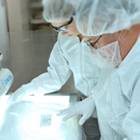Methyl-(R)-(+)-lactat
Artikel-Nr:
(BOSSBS-8071R-CY7)
Lieferant:
Bioss
Hersteller-Artikelnummer::
BS-8071R-CY7
Lokale Artikelnummer::
BOSSBS-8071R-CY7
Beschreibung:
May be a chaperone-like protein essential for the proper conformation and functioning of protein complexes in the respiratory chain.Tissue specificity:Ubiquitously expressed with a relatively greater abundance in heart and skeletal muscle.Involvement in disease:Defects in ADCK3 are a cause of coenzyme Q10 deficiency (CoQ10 deficiency). CoQ10 deficiency is an autosomal recessive disorder with variable manifestations. It can be associated with three main clinical phenotypes: a predominantly myopathic form with central nervous system involvement, an infantile encephalomyopathy with renal dysfunction and an ataxic form with cerebellar atrophy.Defects in ADCK3 are the cause of spinocerebellar ataxia autosomal recessive type 9 (SCAR9) [MIM:612016]; also known as autosomal recessive cerebellar ataxia type 2 (ARCA2). Spinocerebellar ataxia is a clinically and genetically heterogeneous group of cerebellar disorders. Patients show progressive incoordination of gait and often poor coordination of hands, speech and eye movements, due to degeneration of the cerebellum with variable involvement of the brainstem and spinal cord. SCAR9 is an autosomal recessive form characterized by gait ataxia and cerebellar atrophy with slow progression and few associated features. Patients can manifest brisk tendon reflexes and Hoffmann sign, mild psychomotor retardation, mild axonal degeneration of the sural nerve, exercise intolerance and elevated serum lactate.
VE:
1 * 100 µl
Artikel-Nr:
(BOSSBS-12998R-A350)
Lieferant:
Bioss
Hersteller-Artikelnummer::
BS-12998R-A350
Lokale Artikelnummer::
BOSSBS-12998R-A350
Beschreibung:
Glucose and insulin are anabolic signals which upregulate the transcriptions of a series of lipogenic enzymes to convert excess carbohydrate into triglycerides for efficient energy storage. Acyl-coenzyme A:diacylglycerol acyltransferase, also known as DGAT1 and ARGP1, is a microsomal enzyme that assists in the synthesis of fatty acids into triglycerides. DGAT1 catalyzes the terminal and only committed step in triacylglycerol synthesis by using diacylglycerol (DAG) and fatty acyl CoA as substrates. DGAT1 plays a fundamental role in the metabolism of cellular diacylglycerol and is important in higher eukaryotes for physiologic processes involving triacylglycerol metabolism, such as intestinal fat absorption, lipoprotein assembly, adipose tissue form-ation and lactation. DGAT2, which has no homology to DGAT1, differs from DGAT1 in that its activity has been shown to be inhibited by MgCl in an in vitro assay. DGAT2 is expressed primarily in liver and white adipose tissue, which suggests that it plays an important role in mammalian triglyceride metabolism.
VE:
1 * 100 µl
Lieferant:
Sigma-Aldrich
Beschreibung:
L-Lactat-Dehydrogenase
Artikel-Nr:
(BOSSBS-8071R-CY3)
Lieferant:
Bioss
Hersteller-Artikelnummer::
BS-8071R-CY3
Lokale Artikelnummer::
BOSSBS-8071R-CY3
Beschreibung:
May be a chaperone-like protein essential for the proper conformation and functioning of protein complexes in the respiratory chain.Tissue specificity:Ubiquitously expressed with a relatively greater abundance in heart and skeletal muscle.Involvement in disease:Defects in ADCK3 are a cause of coenzyme Q10 deficiency (CoQ10 deficiency). CoQ10 deficiency is an autosomal recessive disorder with variable manifestations. It can be associated with three main clinical phenotypes: a predominantly myopathic form with central nervous system involvement, an infantile encephalomyopathy with renal dysfunction and an ataxic form with cerebellar atrophy.Defects in ADCK3 are the cause of spinocerebellar ataxia autosomal recessive type 9 (SCAR9) [MIM:612016]; also known as autosomal recessive cerebellar ataxia type 2 (ARCA2). Spinocerebellar ataxia is a clinically and genetically heterogeneous group of cerebellar disorders. Patients show progressive incoordination of gait and often poor coordination of hands, speech and eye movements, due to degeneration of the cerebellum with variable involvement of the brainstem and spinal cord. SCAR9 is an autosomal recessive form characterized by gait ataxia and cerebellar atrophy with slow progression and few associated features. Patients can manifest brisk tendon reflexes and Hoffmann sign, mild psychomotor retardation, mild axonal degeneration of the sural nerve, exercise intolerance and elevated serum lactate.
VE:
1 * 100 µl
Artikel-Nr:
(BOSSBS-8071R-CY5.5)
Lieferant:
Bioss
Hersteller-Artikelnummer::
BS-8071R-CY5.5
Lokale Artikelnummer::
BOSSBS-8071R-CY5.5
Beschreibung:
May be a chaperone-like protein essential for the proper conformation and functioning of protein complexes in the respiratory chain.Tissue specificity:Ubiquitously expressed with a relatively greater abundance in heart and skeletal muscle.Involvement in disease:Defects in ADCK3 are a cause of coenzyme Q10 deficiency (CoQ10 deficiency). CoQ10 deficiency is an autosomal recessive disorder with variable manifestations. It can be associated with three main clinical phenotypes: a predominantly myopathic form with central nervous system involvement, an infantile encephalomyopathy with renal dysfunction and an ataxic form with cerebellar atrophy.Defects in ADCK3 are the cause of spinocerebellar ataxia autosomal recessive type 9 (SCAR9) [MIM:612016]; also known as autosomal recessive cerebellar ataxia type 2 (ARCA2). Spinocerebellar ataxia is a clinically and genetically heterogeneous group of cerebellar disorders. Patients show progressive incoordination of gait and often poor coordination of hands, speech and eye movements, due to degeneration of the cerebellum with variable involvement of the brainstem and spinal cord. SCAR9 is an autosomal recessive form characterized by gait ataxia and cerebellar atrophy with slow progression and few associated features. Patients can manifest brisk tendon reflexes and Hoffmann sign, mild psychomotor retardation, mild axonal degeneration of the sural nerve, exercise intolerance and elevated serum lactate.
VE:
1 * 100 µl
Artikel-Nr:
(BOSSBS-8071R-A488)
Lieferant:
Bioss
Hersteller-Artikelnummer::
BS-8071R-A488
Lokale Artikelnummer::
BOSSBS-8071R-A488
Beschreibung:
May be a chaperone-like protein essential for the proper conformation and functioning of protein complexes in the respiratory chain.Tissue specificity:Ubiquitously expressed with a relatively greater abundance in heart and skeletal muscle.Involvement in disease:Defects in ADCK3 are a cause of coenzyme Q10 deficiency (CoQ10 deficiency). CoQ10 deficiency is an autosomal recessive disorder with variable manifestations. It can be associated with three main clinical phenotypes: a predominantly myopathic form with central nervous system involvement, an infantile encephalomyopathy with renal dysfunction and an ataxic form with cerebellar atrophy.Defects in ADCK3 are the cause of spinocerebellar ataxia autosomal recessive type 9 (SCAR9) [MIM:612016]; also known as autosomal recessive cerebellar ataxia type 2 (ARCA2). Spinocerebellar ataxia is a clinically and genetically heterogeneous group of cerebellar disorders. Patients show progressive incoordination of gait and often poor coordination of hands, speech and eye movements, due to degeneration of the cerebellum with variable involvement of the brainstem and spinal cord. SCAR9 is an autosomal recessive form characterized by gait ataxia and cerebellar atrophy with slow progression and few associated features. Patients can manifest brisk tendon reflexes and Hoffmann sign, mild psychomotor retardation, mild axonal degeneration of the sural nerve, exercise intolerance and elevated serum lactate.
VE:
1 * 100 µl
Artikel-Nr:
(BOSSBS-8071R-A680)
Lieferant:
Bioss
Hersteller-Artikelnummer::
BS-8071R-A680
Lokale Artikelnummer::
BOSSBS-8071R-A680
Beschreibung:
May be a chaperone-like protein essential for the proper conformation and functioning of protein complexes in the respiratory chain.Tissue specificity:Ubiquitously expressed with a relatively greater abundance in heart and skeletal muscle.Involvement in disease:Defects in ADCK3 are a cause of coenzyme Q10 deficiency (CoQ10 deficiency). CoQ10 deficiency is an autosomal recessive disorder with variable manifestations. It can be associated with three main clinical phenotypes: a predominantly myopathic form with central nervous system involvement, an infantile encephalomyopathy with renal dysfunction and an ataxic form with cerebellar atrophy.Defects in ADCK3 are the cause of spinocerebellar ataxia autosomal recessive type 9 (SCAR9) [MIM:612016]; also known as autosomal recessive cerebellar ataxia type 2 (ARCA2). Spinocerebellar ataxia is a clinically and genetically heterogeneous group of cerebellar disorders. Patients show progressive incoordination of gait and often poor coordination of hands, speech and eye movements, due to degeneration of the cerebellum with variable involvement of the brainstem and spinal cord. SCAR9 is an autosomal recessive form characterised by gait ataxia and cerebellar atrophy with slow progression and few associated features. Patients can manifest brisk tendon reflexes and Hoffmann sign, mild psychomotor retardation, mild axonal degeneration of the sural nerve, exercise intolerance and elevated serum lactate.
VE:
1 * 100 µl
Artikel-Nr:
(BOSSBS-8071R-A555)
Lieferant:
Bioss
Hersteller-Artikelnummer::
BS-8071R-A555
Lokale Artikelnummer::
BOSSBS-8071R-A555
Beschreibung:
May be a chaperone-like protein essential for the proper conformation and functioning of protein complexes in the respiratory chain.Tissue specificity:Ubiquitously expressed with a relatively greater abundance in heart and skeletal muscle.Involvement in disease:Defects in ADCK3 are a cause of coenzyme Q10 deficiency (CoQ10 deficiency). CoQ10 deficiency is an autosomal recessive disorder with variable manifestations. It can be associated with three main clinical phenotypes: a predominantly myopathic form with central nervous system involvement, an infantile encephalomyopathy with renal dysfunction and an ataxic form with cerebellar atrophy.Defects in ADCK3 are the cause of spinocerebellar ataxia autosomal recessive type 9 (SCAR9) [MIM:612016]; also known as autosomal recessive cerebellar ataxia type 2 (ARCA2). Spinocerebellar ataxia is a clinically and genetically heterogeneous group of cerebellar disorders. Patients show progressive incoordination of gait and often poor coordination of hands, speech and eye movements, due to degeneration of the cerebellum with variable involvement of the brainstem and spinal cord. SCAR9 is an autosomal recessive form characterized by gait ataxia and cerebellar atrophy with slow progression and few associated features. Patients can manifest brisk tendon reflexes and Hoffmann sign, mild psychomotor retardation, mild axonal degeneration of the sural nerve, exercise intolerance and elevated serum lactate.
VE:
1 * 100 µl
Artikel-Nr:
(427211-50)
Lieferant:
Merck Millipore (Calbiochem)
Hersteller-Artikelnummer::
427211-50
Lokale Artikelnummer::
CALB427211-50
Beschreibung:
Pig L-Lactate dehydrogenase (from Heart)
VE:
1 * 50 KU
Artikel-Nr:
(SERA27413.02)
Lieferant:
Serva
Hersteller-Artikelnummer::
27413.02
Lokale Artikelnummer::
SERA27413.02
Beschreibung:
Pig L-Lactate dehydrogenase (from Muscle)
VE:
1 * 100 mg
Artikel-Nr:
(427217-25)
Lieferant:
Merck Millipore (Calbiochem)
Hersteller-Artikelnummer::
427217-25
Lokale Artikelnummer::
CALB427217-25
Beschreibung:
L-Lactat-Dehydrogenase (vom Muskel)
VE:
1 * 25 KU
Artikel-Nr:
(SERA27403.02)
Lieferant:
Serva
Hersteller-Artikelnummer::
27403.02
Lokale Artikelnummer::
SERA27403.02
Beschreibung:
Bovine L-lactate dehydrogenase (from Heart)
VE:
1 * 25 mg
Artikel-Nr:
(BOSSBS-8071R-HRP)
Lieferant:
Bioss
Hersteller-Artikelnummer::
BS-8071R-HRP
Lokale Artikelnummer::
BOSSBS-8071R-HRP
Beschreibung:
May be a chaperone-like protein essential for the proper conformation and functioning of protein complexes in the respiratory chain.Tissue specificity:Ubiquitously expressed with a relatively greater abundance in heart and skeletal muscle.Involvement in disease:Defects in ADCK3 are a cause of coenzyme Q10 deficiency (CoQ10 deficiency). CoQ10 deficiency is an autosomal recessive disorder with variable manifestations. It can be associated with three main clinical phenotypes: a predominantly myopathic form with central nervous system involvement, an infantile encephalomyopathy with renal dysfunction and an ataxic form with cerebellar atrophy.Defects in ADCK3 are the cause of spinocerebellar ataxia autosomal recessive type 9 (SCAR9) [MIM:612016]; also known as autosomal recessive cerebellar ataxia type 2 (ARCA2). Spinocerebellar ataxia is a clinically and genetically heterogeneous group of cerebellar disorders. Patients show progressive incoordination of gait and often poor coordination of hands, speech and eye movements, due to degeneration of the cerebellum with variable involvement of the brainstem and spinal cord. SCAR9 is an autosomal recessive form characterized by gait ataxia and cerebellar atrophy with slow progression and few associated features. Patients can manifest brisk tendon reflexes and Hoffmann sign, mild psychomotor retardation, mild axonal degeneration of the sural nerve, exercise intolerance and elevated serum lactate.
VE:
1 * 100 µl
Artikel-Nr:
(SIALL7525-12.5KU)
Lieferant:
Sigma-Aldrich
Hersteller-Artikelnummer::
L7525-12.5KU
Lokale Artikelnummer::
SIALL7525-12.5KU
Beschreibung:
Pig L-Lactate dehydrogenase (from Heart)
VE:
1 * 12,5 KU
Artikel-Nr:
(BOSSBS-8071R-FITC)
Lieferant:
Bioss
Hersteller-Artikelnummer::
BS-8071R-FITC
Lokale Artikelnummer::
BOSSBS-8071R-FITC
Beschreibung:
May be a chaperone-like protein essential for the proper conformation and functioning of protein complexes in the respiratory chain.Tissue specificity:Ubiquitously expressed with a relatively greater abundance in heart and skeletal muscle.Involvement in disease:Defects in ADCK3 are a cause of coenzyme Q10 deficiency (CoQ10 deficiency). CoQ10 deficiency is an autosomal recessive disorder with variable manifestations. It can be associated with three main clinical phenotypes: a predominantly myopathic form with central nervous system involvement, an infantile encephalomyopathy with renal dysfunction and an ataxic form with cerebellar atrophy.Defects in ADCK3 are the cause of spinocerebellar ataxia autosomal recessive type 9 (SCAR9) [MIM:612016]; also known as autosomal recessive cerebellar ataxia type 2 (ARCA2). Spinocerebellar ataxia is a clinically and genetically heterogeneous group of cerebellar disorders. Patients show progressive incoordination of gait and often poor coordination of hands, speech and eye movements, due to degeneration of the cerebellum with variable involvement of the brainstem and spinal cord. SCAR9 is an autosomal recessive form characterized by gait ataxia and cerebellar atrophy with slow progression and few associated features. Patients can manifest brisk tendon reflexes and Hoffmann sign, mild psychomotor retardation, mild axonal degeneration of the sural nerve, exercise intolerance and elevated serum lactate.
VE:
1 * 100 µl
Lieferant:
Serva
Beschreibung:
L-Lactat-Dehydrogenase (vom Muskel)
Preis auf Anfrage
Lager für diesen Artikel ist begrenzt, kann aber in einem Lagerhaus in Ihrer Nähe zur Verfügung. Bitte stellen Sie sicher, dass Sie in sind angemeldet auf dieser Seite, so dass verfügbare Bestand angezeigt werden können. Wenn das
Lager für diesen Artikel ist begrenzt, kann aber in einem Lagerhaus in Ihrer Nähe zur Verfügung. Bitte stellen Sie sicher, dass Sie in sind angemeldet auf dieser Seite, so dass verfügbare Bestand angezeigt werden können. Wenn das
Dieses Produkt kann nur an eine Lieferadresse versandt werden die über die entsprechende Lizenzen verfügt. Für weitere Hilfe bitte kontaktieren Sie Ihr VWR Vertriebszentrum.
-Additional Documentation May be needed to purchase this item. A VWR representative will contact you if needed.
Dieses Produkt wurde von Ihrer Organisation gesperrt. Bitte kontaktieren Sie Ihren Einkauf für weitere Informationen.
Dieses Produkt ist Ersatz für den von Ihnen gewünschten Artikel.
Dieses Produkt ist nicht mehr verfügbar. Bitte kontaktieren Sie den VWR Kundenservice.
|
|||||||||

















































